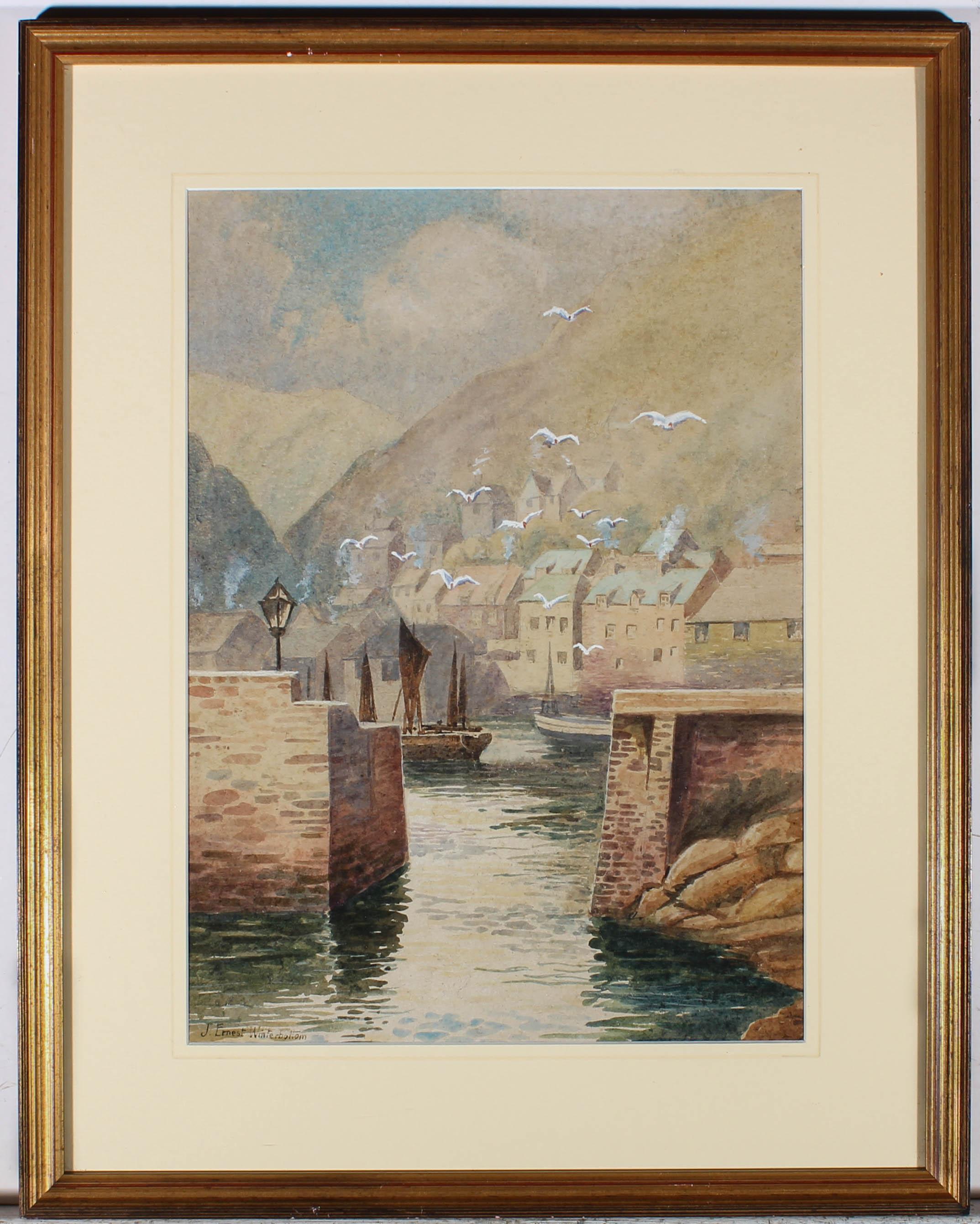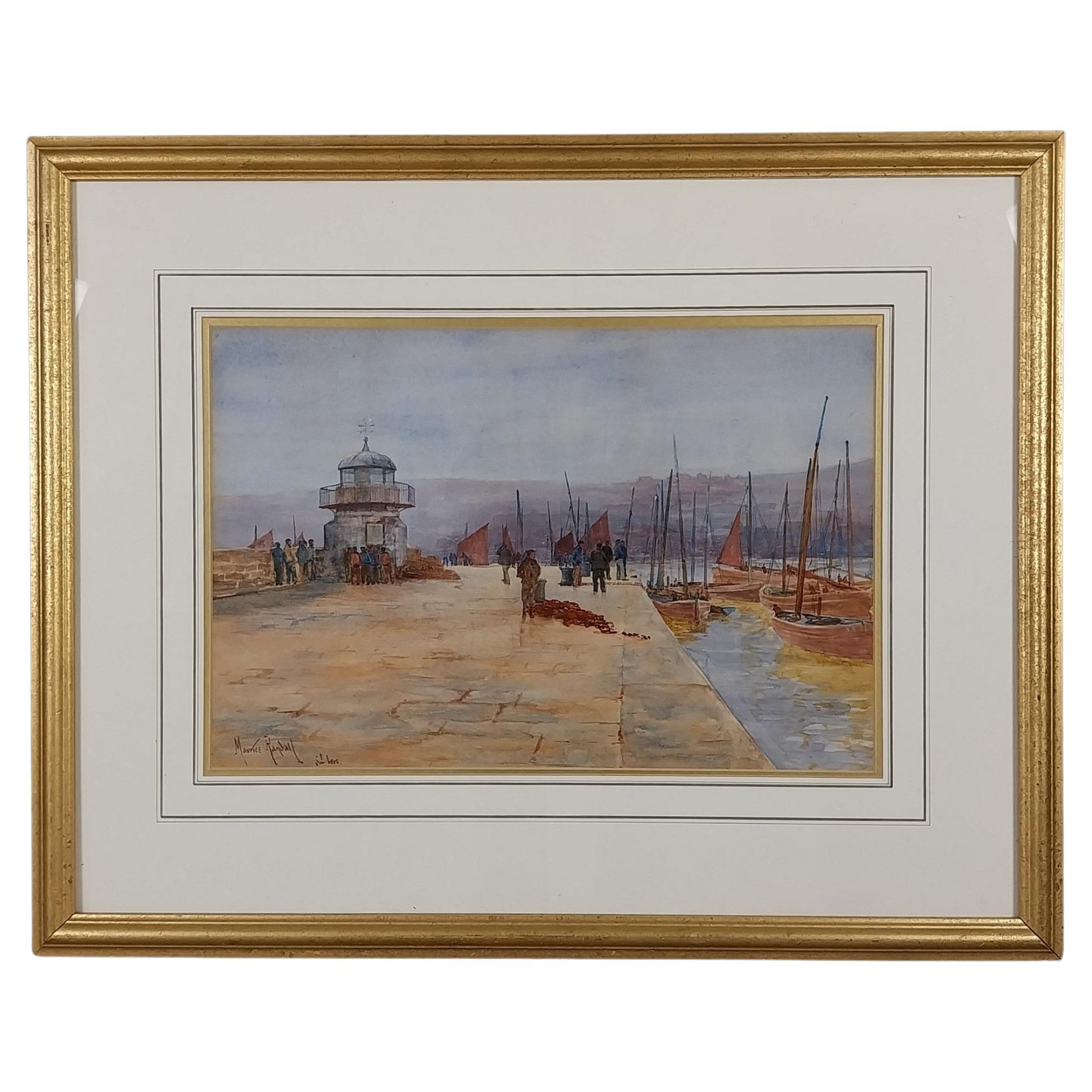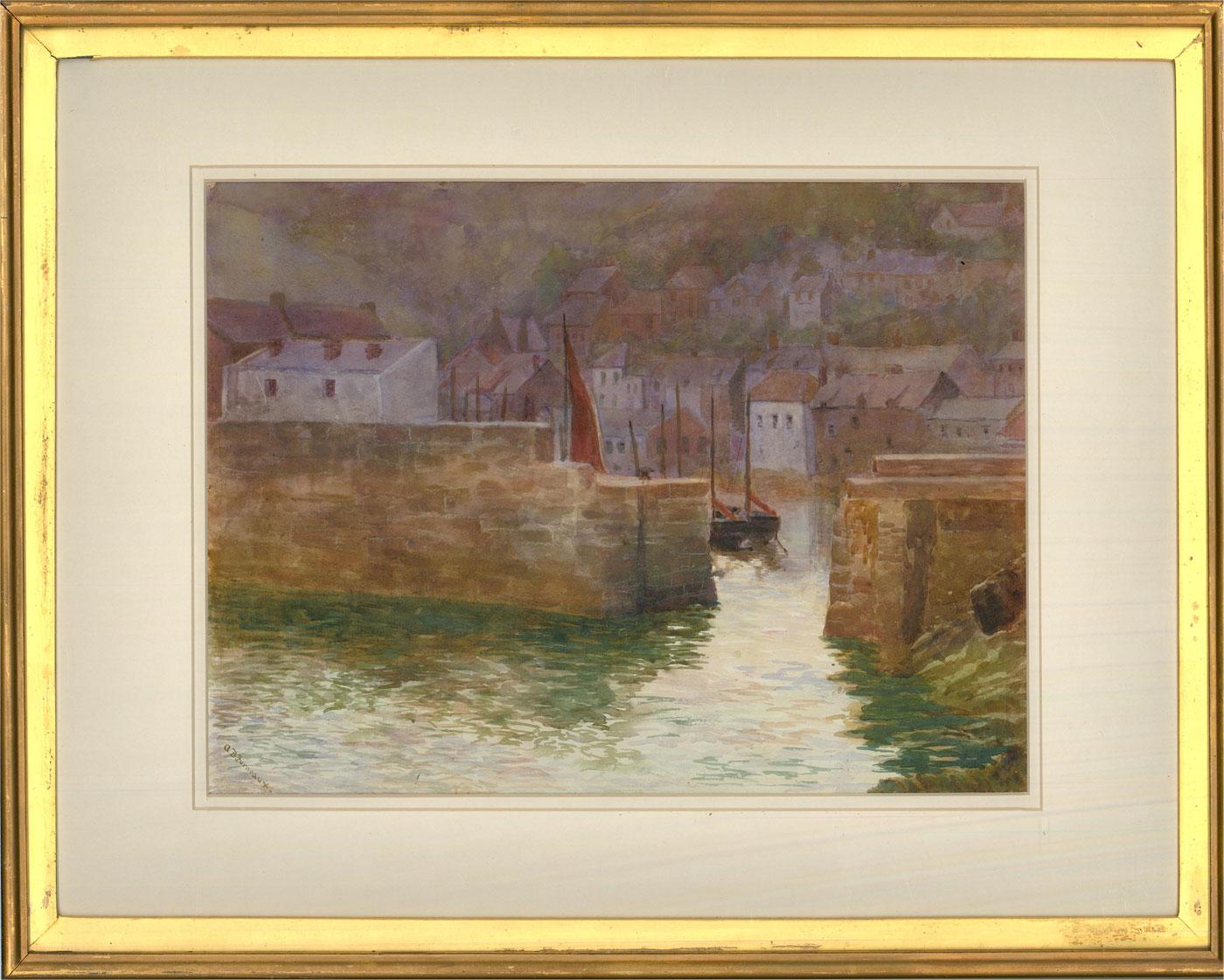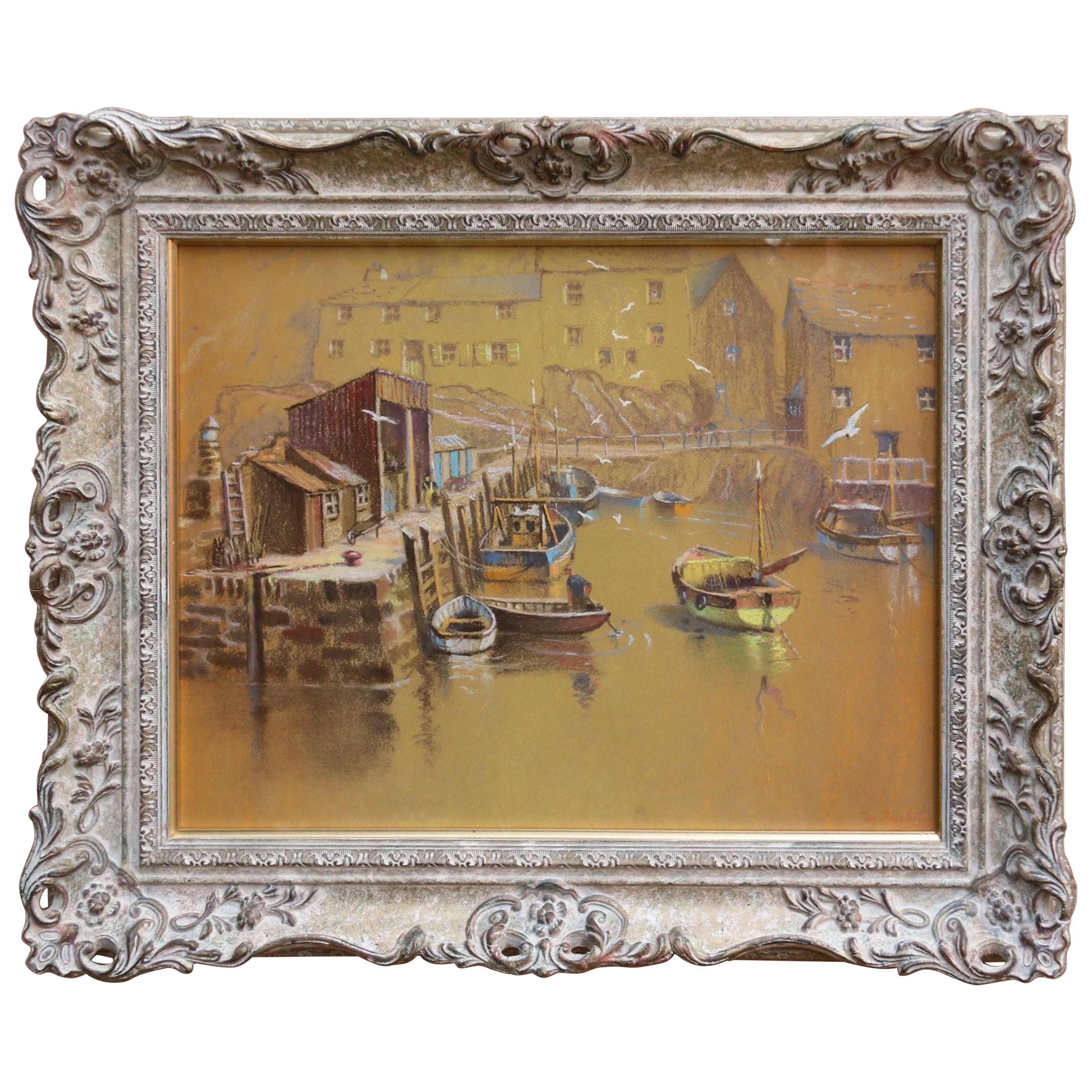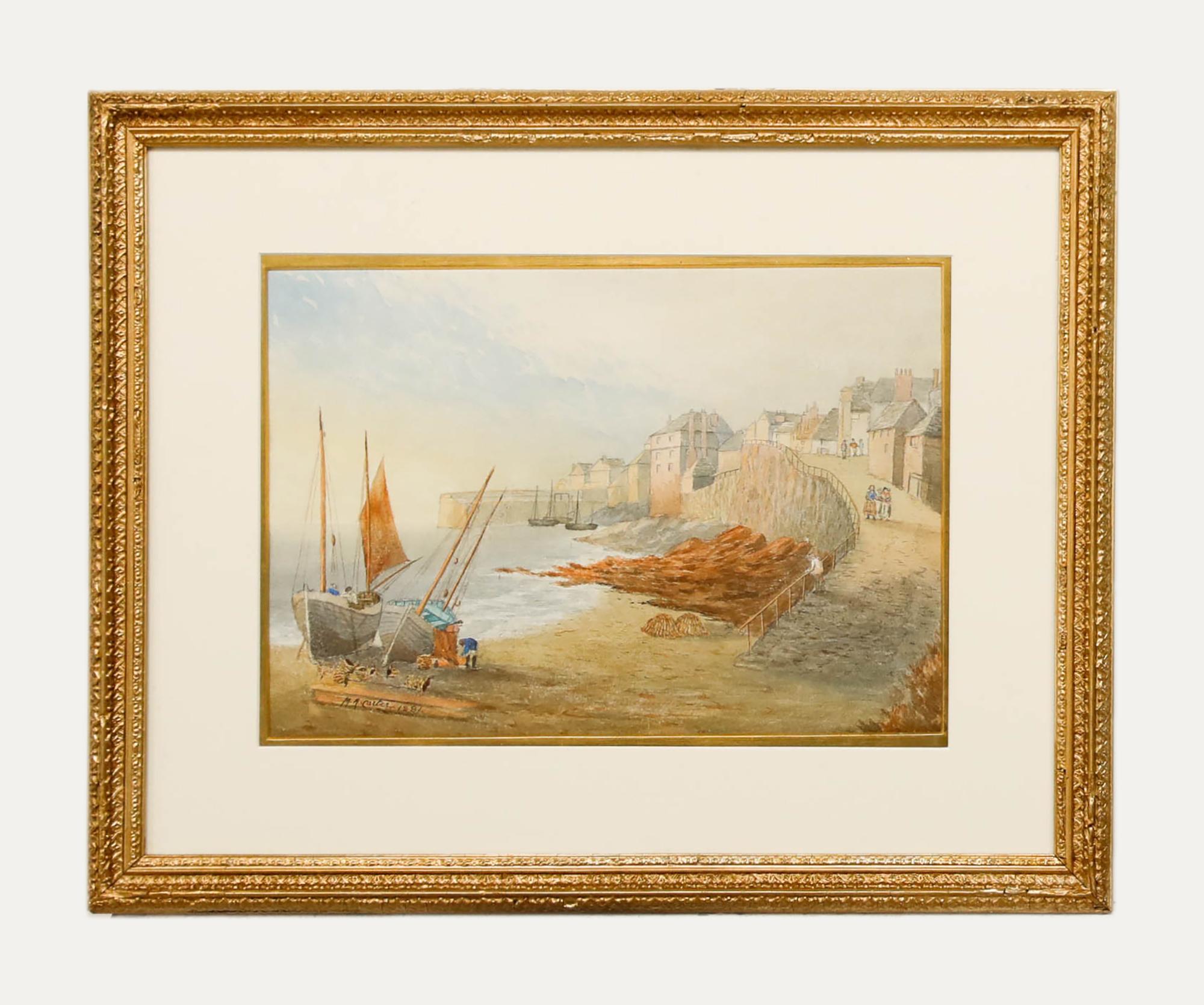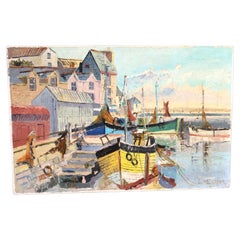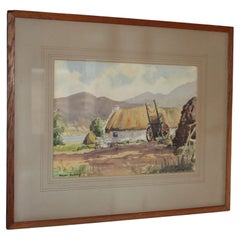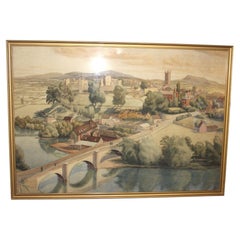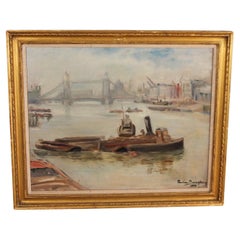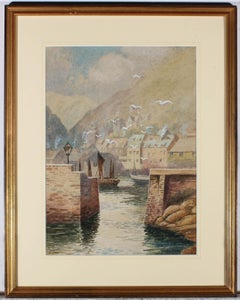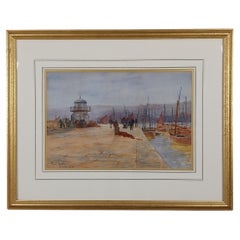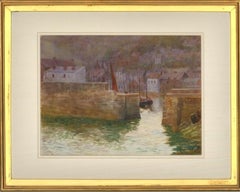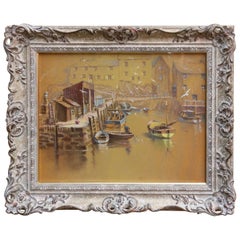Items Similar to Watercolour of Mousehole, Cornwall, England by T H Victor
Want more images or videos?
Request additional images or videos from the seller
1 of 13
Watercolour of Mousehole, Cornwall, England by T H Victor
$1,205.97
£880
€1,026.66
CA$1,651.88
A$1,837.25
CHF 959.35
MX$22,357.36
NOK 12,252.42
SEK 11,490.60
DKK 7,662.38
Shipping
Retrieving quote...The 1stDibs Promise:
Authenticity Guarantee,
Money-Back Guarantee,
24-Hour Cancellation
About the Item
Pretty Watercolour Painting of Mousehole Harbour, Cornwall – T.H. Victor (1894-1980)
Stunning Original Artwork – Signed by Renowned Cornish Artist
Enhance your art collection with this beautiful watercolour painting of Mousehole Harbour in Cornwall, created by the acclaimed artist T.H. Victor (Thomas Herbert Victor, 1894-1980). This vibrant seascape captures the charm of the Cornish fishing village, featuring soft, natural hues that bring the scene to life.
Key Features: Watercolour Painting of Mousehole Harbour, Cornwall
✔ Artist: T.H. Victor (1894-1980), known for his Cornish coastal watercolours
✔ Title: Mousehole Harbour, Cornwall
✔ Signed: Bottom right – T.H. Victor
✔ Inscription: Bottom left – “Mousehole”
Painting Dimensions: Original Watercolour of Mousehole, Cornwall
Image Size: 26 cm (L) x 16 cm (H)
Mounted & Framed: 2-inch depth
Frame: High-quality gold-coloured wooden frame
Frame Size: 39 cm (L) x 31 cm (H)
About the Artist – T.H. Victor
T.H. Victor was a renowned British watercolourist, specialising in Cornish harbour scenes and coastal landscapes. He briefly studied at the Penzance School of Art but declined a scholarship to the Slade School of Fine Art, choosing instead to remain in Cornwall, where he perfected his distinct style.
Shipping
✅ Worldwide Shipping Available – Delicately packaged to ensure safe delivery.
✅ Contact us for an international shipping quote..
Own a piece of authentic Cornish artwork – perfect for collectors, interior designers, or those who appreciate coastal scenery paintings.
🎨 Order today and bring the beauty of Mousehole Harbour into your home
- Dimensions:Height: 12.21 in (31 cm)Width: 15.36 in (39 cm)Depth: 1.58 in (4 cm)
- Style:Arts and Crafts (Of the Period)
- Materials and Techniques:
- Place of Origin:
- Period:
- Date of Manufacture:1950
- Condition:Wear consistent with age and use.
- Seller Location:Seaford, GB
- Reference Number:1stDibs: LU10376244827282
About the Seller
New to 1stDibs
Joined in the past six months.
No Reviews Yet
Vetted Professional Seller
Every seller passes strict standards for authenticity and reliability
Established in 2021
1stDibs seller since 2025
Typical response time: 1 hour
- ShippingRetrieving quote...Shipping from: Seaford, United Kingdom
- Return Policy
Authenticity Guarantee
In the unlikely event there’s an issue with an item’s authenticity, contact us within 1 year for a full refund. DetailsMoney-Back Guarantee
If your item is not as described, is damaged in transit, or does not arrive, contact us within 7 days for a full refund. Details24-Hour Cancellation
You have a 24-hour grace period in which to reconsider your purchase, with no questions asked.Vetted Professional Sellers
Our world-class sellers must adhere to strict standards for service and quality, maintaining the integrity of our listings.Price-Match Guarantee
If you find that a seller listed the same item for a lower price elsewhere, we’ll match it.Trusted Global Delivery
Our best-in-class carrier network provides specialized shipping options worldwide, including custom delivery.More From This Seller
View AllFrench Riviera Mediterranean Harbour Scene
Located in Seaford, GB
Fabulous Midcentury South of France Mediterranean Harbour Scene – South Of France Mediterranean Oil Painting
This exquisite South of France Mediterranean Oil Painting beautifully captures the essence of a South of France coastal scene, transporting viewers to a serene sun-drenched port where life moves at a relaxed, rhythmic pace. This vintage seaside artwork is a masterful portrayal of the picturesque fishing villages of the French Riviera, featuring azure blue waters, colourful boats, and rustic whitewashed buildings with terracotta rooftops.
The artist’s expressive brushstrokes and keen eye for detail bring to life the tranquillity of the Mediterranean, making this piece a perfect addition to any coastal home, vintage art collection, or midcentury-inspired interior. Whether displayed in a Sussex beach house, a contemporary living space, or a collector’s gallery, this artwork captures the warm, nostalgic charm of a bygone era.
South Of France Mediterranean Oil Painting – A Timeless Coastal Masterpiece
The focal point of this painting is the harbour’s crystal-clear waters, where a fleet of traditional fishing boats floats gently, their vivid reds, blues, and yellows contrasting against the deep turquoise sea. The artist expertly conveys the movement of the water, reflecting the brilliance of the sun and the soft dance of the ripples. Fishing nets, mooring ropes, and maritime gear are scattered along the quayside, suggesting a day’s work is completed, adding an element of authenticity and character to the composition.
Beyond the boats, a charming row of Mediterranean buildings lines the harbour, their sun-bleached facades glowing in warm ochres, soft creams, and earthy oranges. These structures, reminiscent of Provençal architecture, exude rustic elegance, with wrought-iron balconies, wooden shutters, and cascading bougainvillaea adding charm. The artist has captured the laid-back atmosphere of a French coastal town, making this painting an inviting French Riviera wall art piece that radiates warmth and nostalgia.
Seaside Village Life – A Celebration of Mediterranean Culture
On the quayside, villagers and fishermen are depicted through loose yet expressive brushstrokes, illustrating the bustling yet peaceful rhythm of daily Mediterranean life. Whether mending nets, chatting along the harbour, or preparing to set sail, the figures add a dynamic yet harmonious element to the scene, embodying the spirit of French coastal living.
The inclusion of palm trees, sun-drenched stone streets, and lush greenery enhances the atmosphere, reinforcing the idyllic charm of this vintage seascape painting...
Category
Mid-20th Century French Mid-Century Modern Decorative Art
Materials
Acrylic
Vintage pair of Donegal ireland watercolours by Frank Murphy
Located in Seaford, GB
Pair of Vintage Irish Donegal watercolours by Frank Murphy R.H.A., R.U.A.
This pair of Vintage Irish Donegal watercolours by Frank Murphy R.H.A., R.U.A. captures the timeless beauty of the Irish landscape. Murphy, a celebrated artist, is renowned for his ability to bring the Donegal countryside to life with his watercolours. These two paintings are fine examples of his skill and deep connection to Irish rural life.
First Watercolour: Thatched Farm Building
The first painting depicts a traditional thatched farm building with the Donegal mountains in the background. The artist uses a soft watercolour wash technique to create a serene atmosphere. The muted tones of the land blend seamlessly with the details of the thatched roof, evoking a sense of peace. Murphy expertly highlights the contrast between the quiet farm and the imposing mountains.
The artist’s signature is located in the lower left corner, with the mount inscribed, "nr Cresslough, Donegal." This specific location adds a personal touch, grounding the painting in a real place.
Second Watercolour: Thatched Houses by the Sea
The second Irish watercolour shows thatched houses by the sea, with the Donegal mountains rising in the background. The scene conveys the peacefulness of Donegal’s coastline. The calm sea and coastal thatched houses reflect the simplicity and beauty of rural Irish life. Murphy uses light and color to give life to the scene, drawing attention to the contrast between the sea and the homes.
The donegal coastline is painted in soft blues and greens, capturing its natural beauty. The mountainous backdrop creates a striking balance, highlighting the ruggedness of the land.
Key Features of Frank Murphy’s Work
Thatched Buildings: A recurring theme in Murphy’s paintings, reflecting traditional Irish architecture.
Donegal Landscape: Both pieces showcase the rugged beauty of Donegal’s mountains and coastline.
Watercolour Technique: Murphy’s skilful use of the watercolour wash technique creates a soft, atmospheric feel in his works.
Signed Artwork: Both paintings are signed by Frank Murphy and come with inscriptions identifying their locations.
Why These Watercolours Are Special
These Irish watercolours...
Category
Mid-20th Century Irish Paintings
Materials
Paper
Watercolour View of Ludlow castle and Dinham bridge
Located in Seaford, GB
930s Watercolour of Ludlow Castle and Dinham Bridge, Shropshire
A fine and atmospheric original watercolour dating to the 1930s, this expertly rendered landscape captures the histori...
Category
Vintage 1930s British Art Deco Paintings
Materials
Paper
Tugboats on the River Thames with London Bridge – Mid-Century Oil Painting
By Pauline Boumphrey
Located in Seaford, GB
Lovely atmospheric oil painting of tug boats on the River Thames with London Bridge in the background.
This midcentury oil painting captures a dynamic and bustling scene of tugboats ...
Category
Vintage 1950s English Mid-Century Modern Paintings
Materials
Canvas
Early 19th century Capriccio Brazil School Painting
Located in Seaford, GB
Rare Early 19th century Capriccio view of Rio de Janeiro Painting
Probably painted circa 1810 by one of Jean-Baptiste Debret, Italian Students.
Painted on Sailcloth.
Historical Context of Early 19th Century Portuguese Colonial Brazil
1.1 Transition from Colony to Empire
During the early 19th century, Brazil underwent a seismic shift in its political status. Originally a colony under the Portuguese Empire, the arrival of the Portuguese Royal Court in Rio de Janeiro in 1808 rapidly elevated the city’s cultural and political importance. By 1815, Brazil was declared a kingdom united with Portugal, setting the stage for the emergence of the Empire of Brazil in 1822. This period of transformation—often termed the transitional period from colony to empire—fueled a wave of artistic production in cities like Rio de Janeiro.
1.2 European Artistic Influence in Brazil
With the French Artistic Mission in Rio (initiated in 1816) and the presence of various Portuguese and European artists, Brazilian art of the early 1800s began to reflect diverse influences, from neoclassical painting to the early rumblings of romanticism. Painters such as Jean-Baptiste Debret, and Nicolas-Antoine Taunay, and local luminaries like Manuel de Araújo Porto-Alegre contributed to the fine arts tradition in Brazil. Their works featured scenes of local life, portraits of Brazilian society, and imaginative vistas—sometimes referred to as “capriccios,” in which real elements were combined with artistic liberties to create an idealized panorama.
1.3 Rio de Janeiro as Cultural and Political Hub
Rio de Janeiro, often called the Imperial capital after Brazil’s independence, was home to foundational institutions like the Imperial Academy of Fine Arts (Academia Imperial de Belas Artes). Later evolving into the Escola de Belas Artes (School of Fine Arts in Rio), these academies nurtured the talents of emerging painters, who found patronage under the Royal Court and, subsequently, the Imperial Court. The city’s significance was further enhanced by the construction of significant buildings, the modernization of infrastructure, and the mingling of European courtly customs with the traditions of local inhabitants.
. Description of the Octagonal Oil on Canvas: A Capriccio View of Rio de Janeiro
2.1 Composition and Layout
The most striking characteristic of this 19th-century Brazilian art piece is its octagonal shape, a relatively unusual format that draws the viewer’s gaze toward its centre. The composition showcases Rio de Janeiro’s shoreline in the early 1800s, brimming with merchant ships and smaller boats anchored near the shore. On the sand, there is a bustling crowd of local people—men and women carrying food and goods on their heads, loading and unloading boats, and engaging in everyday commerce. The backdrop of soaring mountains suggests Rio’s iconic topography, embodying the landscape that famously defines the city.
2.2 Architectural and Religious Landmarks
On the left side, one can discern the silhouette of a church believed to be Santa Lucia, a significant religious structure in the heart of early 19th-century Rio. This element provides viewers with a tangible reference point, linking the scene to an actual location. However, because this painting is labelled as a “capriccio,” the artist might have taken creative liberties by rearranging or amplifying certain features of the city. The melding of real and idealized elements is characteristic of these imaginative vistas.
2.3 Evoking Daily Life in Colonial Rio
One of the painting’s greatest appeals lies in its portrayal of daily life during the colonial era. Men and women from various backgrounds populate the scene. Some appear to be carrying goods on their heads, a common practice in Brazil that has persisted through different centuries. Others appear to be haggling or trading near small vessels, revealing the commercial pulse of an active port city. This focus on local people, combined with the grandeur of merchant ships, captures the tension and synergy between the every day and the extraordinary—a hallmark of Brazilian colonial painting that balances the grand narratives of empire with the rhythms of ordinary life.
2.4 An Amalgamation of Neoclassical and Romantic Influences
Although academic art in early 19th century Brazil was highly influenced by neoclassicism, the onset of romanticism can be spotted in the emotional portrayal of the sky, the lively palette, and the dramatic emphasis on nature’s beauty (the mountains, in particular). This duality reflects the fine arts tradition in Brazil during the transitional phase when artists were embracing multiple styles. As part of the School of Rio or the Rio de Janeiro school, painters often integrated academic techniques learned from European masters with emerging local subjects and influences.
3. Institutions and Artistic Movements
3.1 Imperial Academy of Fine Arts
Originally known as the Royal School of Sciences, Arts, and Crafts, the Imperial Academy of Fine Arts in Rio de Janeiro was instrumental in shaping 19th-century Brazilian art. Influential artists and teachers from Portugal, France, and other European nations congregated at the Academy, imparting their expertise to native students. As the monarchy consolidated power, the Academy enjoyed royal patronage, leading to the creation of Imperial Academy-style works that combined European academic rigour with Brazilian-themed subject matter.
3.2 Impact of the French Artistic Mission
The French Artistic Mission, which arrived in 1816, played a pivotal role in introducing advanced European artistic techniques, thereby elevating the overall quality of painting in Brazil. Artists like Jean-Baptiste Debret not only documented Brazilian society but also spearheaded the development of a local visual identity that aligned with both academicism and the national context of a blossoming empire. Debret, alongside others such as Nicolas-Antoine Taunay, mentored Brazilian artists, sowing the seeds of what would become the Brazilian academic art movement.
3.3 Religious, Historical, and Landscape Paintings
In addition to everyday scenes and historical compositions, religious iconography remained crucial throughout Portuguese colonial and imperial Brazil. Churches were omnipresent in cityscapes like Rio de Janeiro. Many colonial-era Brazilian portraits...
Category
Antique Early 19th Century Brazilian Spanish Colonial Paintings
Materials
Canvas
$2,960 Sale Price
20% Off
Mid 20th Century Landscape Oil Painting in the Manner of Maurice de Vlaminck –
By Maurice de Vlaminck
Located in Seaford, GB
An evocative early 20th century oil painting, executed in the expressive manner of Maurice de Vlaminck, depicting a tranquil rustic village nestled within a moody, wooded landscape. ...
Category
Mid-20th Century Italian Mid-Century Modern Paintings
Materials
Paper
$712 Sale Price
20% Off
You May Also Like
J Ernest Winterbottom - Signed Early 20th Century Watercolour, Mousehole Harbour
Located in Corsham, GB
A charming watercolour scene from the view of a boat entering the harbour at Mousehole, Cornwall. Signed to the lower left and well presented in a white mount and gilt frame. On wove.
Category
Early 20th Century Figurative Drawings and Watercolors
Materials
Watercolor
Painting of St Ives Cornwall Water Colour Pictures
By Maurice Randall
Located in Staffordshire, GB
St Ives Water Colour Painting Cornwall 19th Century England by Maurice Randall (1865-1950)
Fisherman gathered around the notice board on Smeatons Pier, Saint Ives, Cornwall showing b...
Category
Antique 19th Century English Victorian Paintings
Materials
Canvas
$590 Sale Price
25% Off
A. B. Furneaux - Early 20th Century Watercolour, Mousehole Harbour
Located in Corsham, GB
An utterly charming early 20th Century watercolour view of the opening in the stone walls of Mousehole harbour. Mousehall is a picturesque fishing town in Cornwall which is famous fo...
Category
20th Century Figurative Drawings and Watercolors
Materials
Watercolor
A Delightful Pastel Drawing of The Harbour Polperro, Cornwall c 1950
Located in Central England, GB
A Delightful Pastel Drawing of The Harbour Polperro, Cornwall C 1950 by Roy Stringfellow
This very well drawn and executed 1950s pastel view of the idyllic Polperro fishing harbour ...
Category
20th Century English Edwardian Drawings
Materials
Paper
M. A. Carter - Framed Late 19th Century Watercolour, Preparing Boats at Newlyn
Located in Corsham, GB
A fine late 19th century watercolour depicting fishing boats near the slip at Newlyn. Signed 'M. A. Carter' and dated 1881 to the lower left. Presented in an ornate gilt-effect frame...
Category
Late 19th Century Abstract Expressionist Figurative Drawings and Waterco...
Materials
Watercolor
Looe Town And Harbor Cornwall Circa 1860 Tranquil Cornish Watercolor Painting
Located in Sutton Poyntz, Dorset
J. Wilson.
English ( fl.1837 - 1870 ).
Looe Town & Harbor, Cornwall.
Watercolor.
Monogramed Lower Left.
Image size 6.5 inches x 10.4 inches ( 16.5cm x 26.5cm ).
Frame size 12.6 inc...
Category
Mid-19th Century Victorian Landscape Drawings and Watercolors
Materials
Paper, Watercolor, Gouache
More Ways To Browse
Chinese Silk Painting Birds
Clock Shelf Antique
Curling Stones Used
D Appleton
De Gournay Panels
Deer Head Mount
Delftware And English
Deniere Bronze
Dragon Statue
English Delftware
English Oak Bed
English Oak Tray
Export Chinese Cranes
Faux Book Cabinet
Fiddle Back
Flat File
Frederick Weinberg
Gold Rimmed Tea Cup And Saucer
